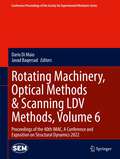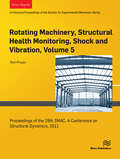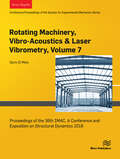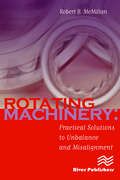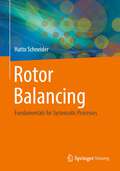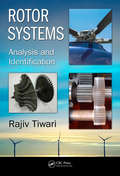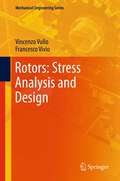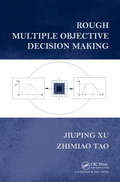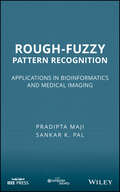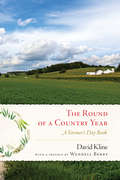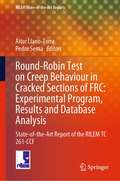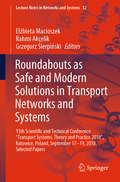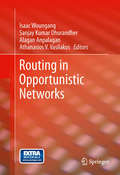- Table View
- List View
Rotating Machinery, Optical Methods & Scanning LDV Methods, Volume 6: Proceedings of the 40th IMAC, A Conference and Exposition on Structural Dynamics 2022 (Conference Proceedings of the Society for Experimental Mechanics Series)
by Dario Di Maio Javad BaqersadRotating Machinery, Optical Methods & Scanning LDV Methods, Volume 6: Proceedings of the 40th IMAC, A Conference and Exposition on Structural Dynamics, 2022, the sixth volume of nine from the Conference brings together contributions to this important area of research and engineering. The collection presents early findings and case studies on fundamental and applied aspects of Structural Health Monitoring, including papers on:Novel TechniquesOptical Methods,Scanning LDV MethodsPhotogrammetry & DICRotating Machinery
Rotating Machinery, Structural Health Monitoring, Shock and Vibration, Volume 5: Proceedings of the 29th IMAC, A Conference on Structural Dynamics, 2011
by Tom ProulxRotating Machinery, Structural Health Monitoring, Shock and Vibration, Volume 5 Proceedings of the 29th IMAC, A Conference and Exposition on Structural Dynamics, 2011, the fifth volume of six from the Conference, brings together 35 contributions to this important area of research and engineering. The collection presents early findings and case studies on fundamental and applied aspects of Rotating Machinery, Structural Health Monitoring, as well as Shock and Vibration, along with other structural engineering areas.
Rotating Machinery, Vibro-Acoustics & Laser Vibrometry, Volume 7: Proceedings of the 36th IMAC, A Conference and Exposition on Structural Dynamics 2018
by Dario Di MaioRotating Machinery, Vibro-Acoustics & Laser Vibrometry, Volume 7: Proceedings of the 36th IMAC, A Conference and Exposition on Structural Dynamics, 2018, the seveth volume of nine from the Conference brings together contributions to this important area of research and engineering. The collection presents early findings and case studies on fundamental and applied aspects of Rotating Machinery, Hybrid Testing, Vibro-Acoustics & Laser Vibrometry, including papers on: Rotating Machinery; Vibro-Acoustics; Experimental Techniques; Scanning Laser Doppler Vibrometry Methods.
Rotating Machinery, Vibro-Acoustics & Laser Vibrometry, Volume 7: Proceedings of the 36th IMAC, A Conference and Exposition on Structural Dynamics 2018 (Conference Proceedings of the Society for Experimental Mechanics Series)
by Dario Di MaioRotating Machinery, Vibro-Acoustics & Laser Vibrometry, Volume 7: Proceedings of the 36th IMAC, A Conference and Exposition on Structural Dynamics, 2018, the seveth volume of nine from the Conference brings together contributions to this important area of research and engineering. The collection presents early findings and case studies on fundamental and applied aspects of Rotating Machinery, Hybrid Testing, Vibro-Acoustics & Laser Vibrometry, including papers on:Rotating MachineryVibro-AcousticsExperimental TechniquesScanning Laser Doppler Vibrometry Methods
Rotating Machinery: Practical Solutions to Unbalance and Misalignment
by Robert B. McMillanA theoretical and practical understanding of unbalance and misalignment in rotating equipment is presented here. These two conditions account for the vast majority of problems with rotating equipment encountered in the real world.;Numerous examples and solutions are included to assist in understanding the various concepts. Included is information on vibration and how it is used to determine the operational integrity of rotating machinery. Also detailed are the relationships between various vibration characteristics which provide an understanding of the forces generated within operating machinery when conditions of unbalance and misalignment are present. Resonance and beat frequencies are detailed along with sources and cures.;Also covered are proper inspection procedures, single plane and dual plane methods of balancing rotating equipment, the three circle method of balancing slow speed fans, advanced rim and face method of precision alignment, and the reverse indicator method of alignment plus much more to fortify the learning experience.
Rotation Sensing with Large Ring Lasers: Applications in Geophysics and Geodesy
by Ulrich Schreiber Jon-Paul WellsRing lasers are commonly used as gyroscopes for aircraft navigation and attitude control. The largest ring lasers are sensitive enough that they can be used for high resolution inertial rotation sensing of the Earth in order to detect tiny perturbations to the Earth's rotation caused by earthquakes or global mass transport. This book describes the latest advances in the development of large ring lasers for applications in geodesy and geophysics using the most sensitive and stable devices available. Chapters cover our current knowledge of the physics of the laser gyroscope, how to acquire and analyse data from ring lasers, and what the potential applications are in the geosciences. It is a valuable reference for those working with ring lasers or using the data for applications in geodesy and geophysics; as well as researchers in laser physics, photonics and navigation.
Rotor Balancing: Fundamentals for Systematic Processes
by Hatto SchneiderFür die Qualitätssicherung von Rotoren ist das Auswuchten ein unverzichtbarer Schritt. Dabei verändern sich mit jeder Weiterentwicklung der Rotoren die Anforderungen an die Auswuchttechnik. Wichtige Prinzipien des Auswuchtens werden in dem Buch erklärt. Es dient als Werkzeug, um die stets neu auftretenden Probleme beim Auswuchten sachgerecht und wirtschaftlich lösen zu können. In der 8. Auflage wird die neue Norm DIN ISO 19499 ausführlich erläutert. Die beabsichtigten Bearbeitungen aller Auswuchtnormen vonseiten des DIN werden erstmals beschrieben.
Rotor Systems: Analysis and Identification
by Rajiv TiwariThe purpose of this book is to give a basic understanding of rotor dynamics phenomena with the help of simple rotor models and subsequently, the modern analysis methods for real life rotor systems. This background will be helpful in the identification of rotor-bearing system parameters and its use in futuristic model-based condition monitoring and, fault diagnostics and prognostics. The book starts with introductory material for finite element methods and moves to linear and non-linear vibrations, continuous systems, vibration measurement techniques, signal processing and error analysis, general identification techniques in engineering systems, and MATLAB analysis of simple rotors. Key Features: • Covers both transfer matrix methods (TMM) and finite element methods (FEM) • Discusses transverse and torsional vibrations • Includes worked examples with simplicity of mathematical background and a modern numerical method approach • Explores the concepts of instability analysis and dynamic balancing • Provides a basic understanding of rotor dynamics phenomena with the help of simple rotor models including modern analysis methods for real life rotor systems.
Rotorcraft Certification by Simulation and Analysis: An Introduction to the Principles and Practices (Springer Aerospace Technology)
by Mark White Gareth D. Padfield Stefan van ‘t Hoff Philipp Hofmeister Linghai Lu Giuseppe QuarantaThis open access book presents the steps necessary for the application of rotorcraft flight modelling and simulation and analysis in support of certification for compliance with EASA CS-27 and CS-29, SUBPART B—FLIGHT and other flight-related rules (e.g. CS-27/9, Appendix B, Airworthiness Criteria for Helicopter Instrument Flight). The material is presented in the form of a structured ‘Rotorcraft Certification by Simulation’ process, starting from the relevant paragraphs in the Certification Specifications, through a comprehensive description of the assembly of flight simulation requirements, informed by judgements on Influence, Predictability and Credibility, and on into the detailed building of the three major elements of the process; the Flight Simulation Model, the Flight Simulator, and the associated Flight Test Measurement System. The latter feeds both the flight model and simulator development with real-world test data to support validation and fidelity assessment. The book is intended to provide support to early adopters of simulation and analysis in the certification process, including those who have considerable experience and expertise in the use of Modelling and Simulation in support of design and development. It is acknowledged that there exists much good practice in the rotorcraft industry in this regard. However, what is presented herein is considered a significant step forward in the development of this practice, particularly in terms of the importance of a structured, requirements-based, process using adaptable-fidelity, descriptive and predictive simulation tools, and associated pre-certification flight testing, to reach the goal of a credible flight simulation.
Rotordynamics (Mechanical Engineering)
by Agnieszka MuszynskaAs the most important parts of rotating machinery, rotors are also the most prone to mechanical vibrations, which may lead to machine failure. Correction is only possible when proper and accurate diagnosis is obtained through understanding of rotor operation and all of the potential malfunctions that may occur. Mathematical modeling, in particular
Rotordynamics of Automotive Turbochargers
by Hung Nguyen-SchäferRotordynamics of automotive turbochargers is dealt with in this book encompassing the widely working field of small turbomachines under real operating conditions at the very high rotor speeds up to 300000 rpm. The broadly interdisciplinary field of turbocharger rotordynamics involves 1) Thermodynamics and Turbo-Matching of Turbochargers 2) Dynamics of Turbomachinery 3) Stability Analysis of Linear Rotordynamics with the Eigenvalue Theory 4) Stability Analysis of Nonlinear Rotordynamics with the Bifurcation Theory 5) Bearing Dynamics of the Oil Film using the Two-Phase Reynolds Equation 6) Computation of Nonlinear Responses of a Turbocharger Rotor 7) Aero and Vibroacoustics of Turbochargers 8) Shop and Trim Balancing at Two Planes of the Rotor 9) Tribology of the Bearing Surface Roughness 10) Design of Turbocharger Platforms using the Similarity Laws The rotor response of an automotive turbocharger at high rotor speeds is studied analytically, computationally, and experimentally. Due to the nonlinear characteristics of the oil-film bearings, some nonlinear responses of the rotor besides the harmonic response 1X, such as oil whirl, oil whip, and modulated frequencies occur in Waterfall diagram. Additionally, the influences of the surface roughness and oil characteristics on the rotor behavior, friction, and wear are discussed. This book is written by an industrial R&D expert with many years of experience in the automotive and turbocharger industries. The all-in-one book of turbochargers is intended for scientific and engineering researchers, practitioners working in the rotordynamics field of automotive turbochargers, and graduate students in applied physics and mechanical engineering.
Rotors: Stress Analysis and Design
by Vincenzo Vullo Francesco VivioStress and strain analysis of rotors subjected to surface and body loads, as well as to thermal loads deriving from temperature variation along the radius, constitutes a classic subject of machine design. Nevertheless attention is limited to rotor profiles for which governing equations are solvable in closed form. Furthermore very few actual engineering issues may relate to structures for which stress and strain analysis in the linear elastic field and, even more, under non-linear conditions (i.e. plastic or viscoelastic conditions) produces equations to be solved in closed form. Moreover, when a product is still in its design stage, an analytical formulation with closed-form solution is of course simpler and more versatile than numerical methods, and it allows to quickly define a general configuration, which may then be fine-tuned using such numerical methods. In this view, all subjects are based on analytical-methodological approach, and some new solutions in closed form are presented. The analytical formulation of problems is always carried out considering actual engineering applications. Moreover, in order to make the use of analytical models even more friendly at the product design stage, a function is introduced whereby it is possible to define a fourfold infinity of disk profiles, solid or annular, concave or convex, converging or diverging. Such subjects, even derived from scientific authors' contributions, are always aimed at designing rotors at the concept stage, i.e. in what precedes detailed design. Among the many contributions, a special mention is due for the following: linear elastic analysis of conical disks and disks with variable profile along its radius according to a power of a linear function, also subjected to thermal load and with variable density; analysis of a variable-profile disk subjected to centrifugal load beyond the material's yield point, introducing the completely general law expressed by a an n-grade polynomial; linear elastic analysis of hyperbolic disk, subjected to thermal load along its radius; linear elastic analysis of a variable-thickness disk according to a power of a linear function, subjected to angular acceleration; etc.
Rough Fuzzy Image Analysis: Foundations and Methodologies (Chapman & Hall/CRC Mathematical and Computational Imaging Sciences Series)
by Sankar K. Pal James F. PetersFuzzy sets, near sets, and rough sets are useful and important stepping stones in a variety of approaches to image analysis. These three types of sets and their various hybridizations provide powerful frameworks for image analysis. Emphasizing the utility of fuzzy, near, and rough sets in image analysis, Rough Fuzzy Image Analysis: Foundations and
Rough Multiple Objective Decision Making
by Jiuping Xu Zhimiao TaoUnder intense scrutiny for the last few decades, Multiple Objective Decision Making (MODM) has been useful for dealing with the multiple-criteria decisions and planning problems associated with many important applications in fields including management science, engineering design, and transportation. Rough set theory has also proved to be an effect
Rough-fuzzy pattern recognition
by Pradipta Maji Sankar K. PalLearn how to apply rough-fuzzy computing techniques to solve problems in bioinformatics and medical image processing Emphasizing applications in bioinformatics and medical image processing, this text offers a clear framework that enables readers to take advantage of the latest rough-fuzzy computing techniques to build working pattern recognition models. The authors explain step by step how to integrate rough sets with fuzzy sets in order to best manage the uncertainties in mining large data sets. Chapters are logically organized according to the major phases of pattern recognition systems development, making it easier to master such tasks as classification, clustering, and feature selection. Rough-Fuzzy Pattern Recognition examines the important underlying theory as well as algorithms and applications, helping readers see the connections between theory and practice. The first chapter provides an introduction to pattern recognition and data mining, including the key challenges of working with high-dimensional, real-life data sets. Next, the authors explore such topics and issues as: Soft computing in pattern recognition and data mining A Mathematical framework for generalized rough sets, incorporating the concept of fuzziness in defining the granules as well as the set Selection of non-redundant and relevant features of real-valued data sets Selection of the minimum set of basis strings with maximum information for amino acid sequence analysis Segmentation of brain MR images for visualization of human tissues Numerous examples and case studies help readers better understand how pattern recognition models are developed and used in practice. This text-covering the latest findings as well as directions for future research-is recommended for both students and practitioners working in systems design, pattern recognition, image analysis, data mining, bioinformatics, soft computing, and computational intelligence.
Round of a Country Year: A Farmer's Day Book
by David KlineDavid Kline has been called a "twentieth–century Henry David Thoreau" by his friends and contemporaries; an apt comparison given the quiet exuberance with which he records the quotidian goings–on on his organic family farm. Under David's attentive gaze and in his clear, insightful prose the reader is enveloped in the rhythms of farm life; not only the planting and harvesting of crops throughout the year, but the migration patterns of birds, the health and virility of honeybees left nearly to their own devices, the songs and silences of frogs and toads, the disappearance and resurgence of praying mantises in fields–turned woodlands, the search for monarch butterflies in the milkweed. There's rhythm in community, too—neighbors gathering to plant potatoes or to maintain an elderly friend's tomato garden, organic farming conferences and meetings around family dining tables or university panels.Interspersed with local lore (when the spring's first bumblebee appears the children can go barefoot) is deep technical knowledge of cultivation and land management and the hazards of modern agri–business. Kline records statewide meetings of district supervisors, knows which speakers and committee chairmen are in the pockets of the oil and gas lobbyists, stands up and says his part.At a time when America's population is being turned toward the benefits of small, local farming practices on our health and our environment, Kline's daybook offers a striking example of the ways in which we are connected to our environment, and the pleasure we can take in daily work and stewardship.
Round-Robin Test on Creep Behaviour in Cracked Sections of FRC: State-of-the-Art Report of the RILEM TC 261-CCF (RILEM State-of-the-Art Reports #34)
by Pedro Serna Aitor Llano-TorreThe book presents the work of the RILEM Technical Committee 261-CCF, which organized the challenging International Round Robin Test (RRT) on the creep behaviour of Fibre Reinforce Concrete (FRC) cracked specimens. Although different creep test methodologies have been developed in recent years, the absence of a standardised creep methodology hindered general comparisons. Therefore, the RILEM TC 261-CCF launched an ambitious international RRT program to improve the knowledge on long-term behaviour of cracked sections of FRC and assess all the different testing methodologies, assuming the big variability of testing criteria among the scientific community. The participation of 19 laboratories across 20 institutions in 14 countries all over the world enabled the realisation of the largest experimental campaign on creep in the cracked state. As a result of the RRT, an extensive database of creep test results was created containing comprehensive information from 124 cracked FRC specimens tested using different creep testing procedures in agreed conditions. The book will benefit academics and practitioners interested in the long-term behaviour of FRC since it served as basis for the recently published RILEM Recommendation on creep testing procedure and represents the current knowledge on creep in cracked FRC specimens.
Roundabouts as Safe and Modern Solutions in Transport Networks and Systems: 15th Scie15th Scientific And Technical Conference Transport Systems. Theory And Practice 2018 , Katowice, Poland, September 17-19, 2018, Selected Papersntific And Technical Conference Transport Systems. Theory And Practice 2018 Selected Papers (Lecture Notes in Networks and Systems #52)
by Elżbieta Macioszek Grzegorz Sierpiński Rahmi AkçelikThis book offers a collection of guidelines that will be particularly useful to those making decisions concerning roundabouts as safe and modern solutions in transport networks and systems. The decision-making support systems described here will interest those who face the challenge of finding solutions to problems concerning modern transport systems on a daily basis. Consequently, the book is chiefly intended for local authorities involved in planning and preparing development strategies for specific transport-related issues (in both urban and regional contexts), as well as for representatives of business and industry who are directly engaged in the implementation of traffic engineering solutions. The guidelines provided in the respective chapters help to address the given problem soundly, and to simplify the selection of an appropriate strategy. The topics covered include traffic conditions and the performance of single-lane, two-lane and turbo roundabouts, road traffic safety analysis, analysis of road traffic safety improvements, surrogate safety measures at roundabouts, analysis of pedestrian behavior at pedestrian crossings with public transport vehicles, methods for assessing vehicle motion trajectory at single-lane roundabouts using visual techniques, making compact two-lane roundabouts effective for vulnerable road users, concepts for wireless electric vehicle charging near roundabouts, work zones, and temporary traffic control at roundabouts. Since the book also considers new approaches to theoretical models (including modeling roundabout capacity, models of critical gaps and follow-up headways for turbo roundabouts, and estimating roundabout delay while taking into account pedestrian impact), it will also appeal to researchers and scientists studying these problems. The book gathers selected papers presented at the 15th Scientific and Technical Conference “Transport Systems. Theory and Practice”, organized by the Department of Transport Systems and Traffic Engineering, Silesian University of Technology in Katowice, Poland on September 17–19, 2018.
Route 66
by David KnudsonBegun in 1926 to connect Chicago to Los Angeles, Route 66 was the country's first major east-west thoroughfare. By 1930 it was an important route for both truckers and travellers alike, and in 1939 it became known as 'The Mother Road' thanks to John Steinbeck's classic "The Grapes of Wrath". Over the years, hundreds of thousands of Americans travelled this great road - from those heading west during the Great Depression to postwar families taking road trips across the country - but by the 1970s four-lane highways, expressways, and tollways had largely supplanted it, and Route 66 fell into disrepair. In this book, authority David Knudson traces the fascinating story of The Mother Road from origins to decline, including the roadside attractions and cottage industries it spawned and the efforts to save and restore it.
Routes of Power
by Christopher F. JonesThe fossil fuel revolution is usually rendered as a tale of historic advances in energy production. In this perspective-changing account, Christopher F. Jones instead tells a story of advances in energy access--canals, pipelines, and wires that delivered power in unprecedented quantities to cities and factories at a great distance from production sites. He shows that in the American mid-Atlantic region between 1820 and 1930, the construction of elaborate transportation networks for coal, oil, and electricity unlocked remarkable urban and industrial growth along the eastern seaboard. But this new transportation infrastructure did not simply satisfy existing consumer demand--it also whetted an appetite for more abundant and cheaper energy, setting the nation on a path toward fossil fuel dependence. Between the War of 1812 and the Great Depression, low-cost energy supplied to cities through a burgeoning delivery system allowed factory workers to mass-produce goods on a scale previously unimagined. It also allowed people and products to be whisked up and down the East Coast at speeds unattainable in a country dependent on wood, water, and muscle. But an energy-intensive America did not benefit all its citizens equally. It provided cheap energy to some but not others; it channeled profits to financiers rather than laborers; and it concentrated environmental harms in rural areas rather than cities. Today, those who wish to pioneer a more sustainable and egalitarian energy order can learn valuable lessons from this history of the nation's first steps toward dependence on fossil fuels.
Routes to Absolute Instability in Porous Media
by Antonio BarlettaThis book addresses the concepts of unstable flow solutions, convective instability and absolute instability, with reference to simple (or toy) mathematical models, which are mathematically simple despite their purely abstract character. Within this paradigm, the book introduces the basic mathematical tools, Fourier transform, normal modes, wavepackets and their dynamics, before reviewing the fundamental ideas behind the mathematical modelling of fluid flow and heat transfer in porous media. The author goes on to discuss the fundamentals of the Rayleigh-Bénard instability and other thermal instabilities of convective flows in porous media, and then analyses various examples of transition from convective to absolute instability in detail, with an emphasis on the formulation, deduction of the dispersion relation and study of the numerical data regarding the threshold of absolute instability. The clear descriptions of the analytical and numerical methods needed to obtain these parametric threshold data enable readers to apply them in different or more general cases. This book is of interest to postgraduates and researchers in mechanical and thermal engineering, civil engineering, geophysics, applied mathematics, fluid mechanics, and energy technology.
Routine Data Processing in Earthquake Seismology
by Jens Havskov Lars OttemollerThe purpose of this book is to get a practical understanding of the most common processing techniques in earthquake seismology. The book deals with manual methods and computer assisted methods. Each topic will be introduced with the basic theory followed by practical examples and exercises. There are manual exercises entirely based on the printed material of the book, as well as computer exercises based on public domain software. Most exercises are computer based. The software used, as well as all test data are available from http://extras.springer.com. This book is intended for everyone processing earthquake data, both in the observatory routine and in connection with research. Using the exercises, the book can also be used as a basis for university courses in earthquake processing. Since the main emphasis is on processing, the theory will only be dealt with to the extent needed to understand the processing steps, however references will be given to where more extensive explanations can be found. Includes: * Exercises * Test data * Public domain software (SEISAN) available from http://extras.springer.com
Routing for Wireless Multi-Hop Networks
by Hossam S. Hassanein Sherin Abdel Hamid Glen TakaharaThe focus of this brief is to identify what unifies and what distinguishes the routing functions in four wireless multi-hop network paradigms. The brief introduces a generic routing model that can be used as a foundation of wireless multi-hop routing protocol analysis and design. It demonstrates that such model can be adopted by any wireless multi-hop routing protocol. Also presented is a glimpse of the ideal wireless multi-hop routing protocol along with several open issues.
Routing in Opportunistic Networks
by Isaac Woungang Alagan Anpalagan Sanjay Kumar Dhurandher Athanasios V. VasilakosRouting in Opportunistic Networks focuses on the basics of opportunistic networks, modeling and communication in opportunistic networks, routing in opportunistic networks, and collaboration and cooperation in opportunistic networks. The editors will cover such topics as mobility characterization and discovery in opportunistic networks, scheduling and medium access control in opportunistic networks as well as testbed, tools, and measurements for opportunistic networks.
Routledge Companion to Real Estate Development
by Richard Peiser Graham Squires Erwin HeurkensReal estate development shapes the way people live and work, playing a crucial role in determining our built environment. Around the world, real estate development reflects both universal human needs and region-specific requirements, and with the rise of globalization there is an increasing need to better understand the full complexity of global real estate development. This Companion provides comprehensive coverage of the major contemporary themes and issues in the field of real estate development research. Topics covered include: social and spatial impact markets and economics organization and management finance and investment environment and sustainability design land use policy and governance. A team of international experts across the fields of real estate, planning, geography, economics and architecture reflect the increasingly interdisciplinary nature of real estate studies, providing the book with a depth and breadth of original research. Following on from the success of the textbook International Approaches to Real Estate Development, the Routledge Companion to Real Estate Development provides the up-to-date research needed for a full and sophisticated understanding of the subject. It will be an invaluable resource to students, researchers and professionals wishing to study real estate development on an international scale.
